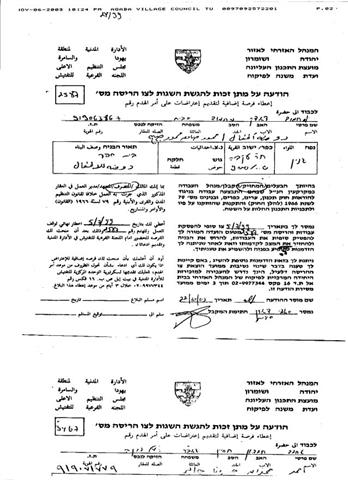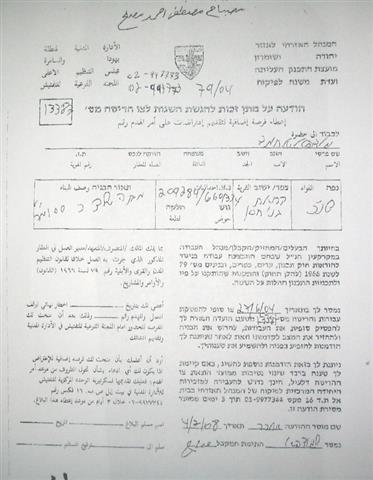On February 2, 2008, the Israeli Occupation Forces distributed four demolition orders to houses in Izbat Al Tabib village east of Qalqilyia city for the fifth time in two years. The orders stated that the houses were built without a proper building license from the Israeli Civil Administration due to their location in area C which falls under the full Israeli control according to Oslo II Interim agreement of 1995. Israeli authorities gave house owners a grace period until the 8th of February to evacuate their houses in preparation for their demolition. The following table lists house owners and a description of their houses.
|
Name |
Structure Description |
|
Hirba Sh’our (75 years old) |
Two rooms + an animal pen |
|
Mustafa Hasan Tabib (67 years old) |
One-story house and an animal pen |
|
Musa Adnan Tabib (54 years old) |
One-story house |
|
Radi Yousef Tabib (43 years old) |
An animal pen |
It should be noted that owners of the houses have already started the process of getting a building license for their houses after they received the first demolition warnings one and a half year ago; however, it was rejected by the Israeli authorities for 'security reasons' and the four families were considered as 'illegal residents' in their own houses and therefore must to be evicted.
( Photo 1: Mr. Musa Adnan Tabib House Threatened Demolition – Ezbat Al Tabib)
( Photo 2: Mr. Radi Yousef Tabib House Threatened Demolition – Ezbat Al Tabib)
As one example of the misery in Izbat Al Tabib village is Hajja Harba Sh’our, a 75 years old lady whose house is threatened to be demolished by the Israeli authorities. Hajja Harba has no source of income and people of the village give some charity to help her survive. If her house is demolished, she would find no other place shelter to live in. Her house was built in year 1974, even before the establishment of Alfe Menshe, Kedumim and Ma’aleh Shomron settlements.
( Picture 3 : Mrs. Hirba Sh’our House Threatened Demolition – Ezbat Al Tabib )
The Israeli Occupation Authorities issued the military order on the 3ed of January 2008 and was signed by the Legal Advisor of the Israeli Civil Administration calling for the establishment of a new colonial road which is to serve the colony of Alfe Menshe. The new road is planned to go through lands where some Palestinian houses exist. The order points out to the “illegal existance' of the houses and that its inhabitants are to be moved to Azoun village located 2 kilometers to the south. Israeli occupation authorities claim that Azoun village can absorb up to 76% of Izbat Al Tabib residents by the year 2015 that is in addition to the village's natural growth. Furthermore, the Order indicated that there is no need for a Master Plan for Izbat Al Tabib as all buildings were built with proper license documents; thus violated Israeli building codes.
The Effects of the Israeli Decision:
-
Financial burden on village's residents as they will pay for the lawyer who will follow up their case at the Israeli court. Not forgetting to mention that villagers suffer from 'high unemployment rate' ever since the eruption of the second Intifada in September 2000 during which they lost their jobs as 'construction workers' inside Israel.
-
The village council contributed financially to help residents build their houses such as infrastructure and other basic services.
-
The latest decision by the Israeli Authorities negatively affected the village's economy; It has a large number of commercial and industrial workshops absorbing a large number of villagers who work in this field. In light of the late Israeli decision, all the shops were forced to close down which led to an increase in 'unemployment rate' in the village to 71%.
-
The decision also affected the stability of villagers as they feared eviction and transfer. Ever since the 1980’s, at least 21 demolition or halt construction orders against houses and animal pens have been issued against the inhabitants of the village. Even the municipal services compound (still under construction) is under the threat of being demolished which affects the presence of the villagers in the future.
-
In addition to the above mentioned points, the people of the village have been affected psychologically due to fear and anxiety.
( Photo 4: An order to stop the construction of the building for
Joint Service at – Ezbat Al Tabib from the Israeli military )
Ezbat Al Tabib: Area & Population
Izbat Al Tabib is located 7 kilometers east of Qalqilyia city and stands on 635 dunums of land. The village's total population is 226 (PCBS 2006) living in 40 houses most of which are covered with zinco and are, thus, not suitable for human living. . Renovation of the houses is prohibited by the Israelis as the village is considered as 'Green Area' upon which no Palestinian construction or land utilization is allowed. The village's total land area falls within 'C' zone according to the Oslo Interim Agreement of 1995.
During the Jordanian rule, about 30 dunums of the village's land were confiscated and declared as 'State Land'. In 1989, Israeli Occupation Authorities confiscated 15 dunums to open up a by-pass road north of the village; later on, when Israel started constructing the Segregation Wall in the West Bank in 2002, Izbat Al Tabib village, as the many Palestinian villages and cities in the WB, lost 180 dunums of lands for that purpose. The village also lost an additional 93 dunums of land beneath the wall. The lost lands were considered as a source of income to some of the families as they were planted with Olive and Citrus trees.
Continuation of House Demolition and Demolition Orders in Far’oan Village – Tulkarem Government
Israeli occupation authorities issued three demolition orders on January 31st, 2008 against three houses for the third time in the village of Far'oun. The orders gave house owners a grace period up to February 3rd, 2008 to vacate the houses. The Orders were issued under the pretext of 'building without license' due to their location in Area C” as well as their close proximity to the Wall (about 240 meters away). It is worth mentioning that these houses were built and present before the erection of the Israeli Segregation Wall. The following table lists the names of the house owners against which the Orders were issued:
|
No. |
Name |
No. of Family Members |
House |
|
1 |
Husam saleem Hasan Aasi (34 years old). A young man who spent his life earnings to build the house in preparation for marriage life. He also supports his mother who lives with him in the house. |
2 |
One-story fully furnished. |
|
2 |
Bassam Saleem Hasan Suleiman (36 years old). He works as a teacher substitute. He worked many years to able to finish his house. He’s been living there since 1999. |
5 |
Two-story house fully furnished. |
|
3 |
Imad Salman Ahmad Hazahza (29 years old) |
7 |
Two-story house; the first is furnished while the second is not completed as of yet. |
Since the early 2006, Israeli occupation forces have carried out 2 demolitions in Far’oan village where 6 Palestinian houses were demolished. 16 other houses in the village are threatened to be demolished. These houses, which were built during the ninties, are located close to the path of the wall. Israeli Authorities did not object to the presence of the houses upon the construciton of the Wall but when the Wall was completed in the village, residents of Far’oan started to receive demolition orders under a number of pretexts, some of which are:
-
The land is “agricultural”, not to be used for building purposes.
-
Outside the Master Plan of the village which cannot be expanded until 2015.
-
Closeness to the Green Line.
Effects of the Demolition Orders on Far’oan Villagers:
As a result of the high frequency of demolition orders and actual demolitions, the people of Far’oan had an increase in the number of cases of anxiety and emotional distress. In addition, the economy has been devastated due to the loss of tens of dunums located near the Wall where no building or agricultural work can be carried out despite the fact that such lands are considered to be the most fertile lands in the Governorate of Tulkarem.
Prepared by
The Land Research Center
LRC

















